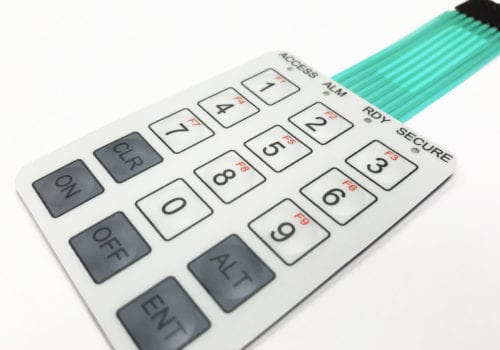The Function of a Membrane Switch in Modern Touch Interfaces and Controls
The Function of a Membrane Switch in Modern Touch Interfaces and Controls
Blog Article
Understanding the Capability of Membrane Layer Changes for User User Interface Devices
The functionality of membrane layer changes stands for a significant advancement in customer interface style, combining performance with visual adaptability. These switches operate with a multi-layered framework that converts customer interactions into electric signals, enabling both compact formats and strength versus ecological elements. As markets increasingly prioritize customer experience, comprehending the nuances of membrane switch modern technology becomes important. What effects do these developments hold for future applications, and just how might they redefine individual communications across different devices?
What Are Membrane Switches?
Membrane layer switches are ingenious user interface gadgets that promote customer communication with digital devices. These flexible elements consist of several layers, consisting of a visuals overlay, spacer, and a published circuit layer. The layout enables a seamless integration into different electronic devices, enhancing both the aesthetic and functional aspects of user interfaces.
Membrane switches are commonly employed in a broad range of applications, from household appliances to industrial machinery and clinical devices. Their construction usually features a thin account, making them an ideal selection for portable styles. The tactile feedback provided by these buttons can be crafted to satisfy particular user choices, ensuring reliable interaction in between the individual and the device.
Resilience is one more significant benefit of membrane switches, as they are immune to dust, moisture, and chemicals, which boosts their life expectancy popular environments. In addition, these switches can be tailored in regards to shape, dimension, and graphic layout, enabling branding and user-specific features. On the whole, membrane layer switches stand for a useful remedy for improving user experience in digital devices, integrating functionality with visual appeal in a reliable way.
Just How Membrane Switches Over Work
Operating on a straightforward concept, membrane changes make use of a layered building and construction to register customer input efficiently. Each button includes numerous layers, including a published circuit layer, a spacer layer, and a top visuals layer, which are designed to interact seamlessly. When an individual presses the leading layer, it compresses the spacer layer, bringing the conductive components of the circuit layer into contact with each various other.
This contact produces a shut circuit, indicating the tool to execute a certain feature. The design permits numerous configurations, including responsive feedback, which can enhance the user experience by giving a physical experience upon activation. The materials utilized in membrane layer buttons commonly consist of versatile substrates, such as polyester or polycarbonate, which make certain longevity and resilience versus wear and tear.

Key Benefits of Membrane Layer Switches

An additional considerable advantage is their density. Membrane buttons are thin and lightweight, which makes it possible for suppliers to save room in their gadgets without sacrificing capability. This function is particularly valuable in applications where weight and volume are critical factors to consider.
Additionally, membrane layer switches are immune to dust, dampness, and chemicals, improving their resilience. This strength extends their life-span and decreases the demand for frequent substitutes, resulting in expense savings gradually.
Moreover, the responsive feedback given by membrane switches can be maximized to enhance individual communication. They can consist of features such as increased switches or audible clicks, enhancing functionality and customer experience.
Applications Across Industries
Interface devices using membrane layer buttons prevail in a large selection of industries, showcasing their versatility and capability. Membrane Switch. In the clinical sector, membrane buttons are integral to devices such as diagnostic devices and patient tracking explanation systems, where their sturdiness and convenience of cleansing are crucial for preserving hygiene requirements. In the auto industry, these buttons are employed in dashboard controls and infotainment systems, providing a sleek and modern interface for users.
Additionally, the customer electronic devices market gain from membrane layer buttons in home appliances and handheld gadgets, where compact layout and straightforward user interfaces boost individual experience. Industrial applications also utilize membrane layer changes for control panels in machinery and automation systems, emphasizing their robustness and resistance to rough settings.
In the aerospace and protection markets, membrane switches are made use of in cabin controls and tools, where integrity and efficiency under extreme conditions are paramount. In addition, the pc gaming market increasingly incorporates membrane layer buttons in controllers and game machines, adding to an interesting individual experience. In general, the flexibility of membrane switches over enables their widespread usage across numerous fields, emphasizing their relevance in contemporary interface layout.
Future Patterns in Membrane Switch Over Modern Technology

Furthermore, using advanced materials, such as polycarbonate and polyester movies, is anticipated to rise, offering improved toughness and resistance to environmental stressors. These materials add to the total longevity of membrane switches, making them appropriate for harsher industrial applications.
Moreover, the consolidation of wise modern technology, consisting of IoT connection, will enable membrane switches to communicate with various other tools and systems, facilitating a more interactive user experience. This pattern straightens with the expanding demand for wise tools throughout numerous fields, from healthcare to consumer electronics.
Lastly, customization options are expected to broaden, enabling producers to create bespoke services tailored to specific user needs and preferences. These developments will certainly place membrane switches as important components in the evolution of customer interface technology.
Verdict
In verdict, membrane switches over stand for a pivotal improvement in customer interface innovation, supplying a trustworthy and versatile option for varied electronic applications. As improvements in product science and touch noticing technologies proceed, the capability and applicability of membrane switches are anticipated to increase, enhancing their value in modern digital devices.
Report this page